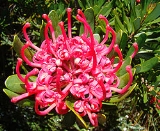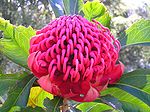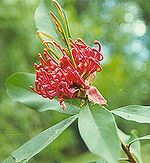
Waratah
Encyclopedia
Waratah is a genus of five species of large shrub
s or small tree
s in the Proteaceae
, native to the southeastern parts of Australia
(New South Wales
, Victoria
and Tasmania
). They have spirally arranged leaves
10-20 cm long and 2-3 cm broad with entire or serrated margins, and large, dense flower
heads 6-15 cm diameter with numerous small red flowers and a basal ring of red bract
s. The name waratah comes from the Eora
Aboriginal people, the original inhabitants of the Sydney
area.
, their closest relatives appear to be the genera Alloxylon
(Tree Waratahs), Oreocallis
and Embothrium
, a group of generally terminal red-flowering plants which skirt the southern edges of the Pacific Rim
. Together they make up the subtribe Embothriinae within the family.
The New South Wales Waratah is native to areas in the Sydney
geological basin, Central and South Coast districts, and in the Blue Mountains; it grows to about 4 m tall. It typically grows in sandy loam
soils along ridges and plateaus. This waratah is endemic to New South Wales, but has now spread due to its popularity, to Victoria and even Tasmania.



 Waratahs are popular, though somewhat tricky to grow, ornamental plant
Waratahs are popular, though somewhat tricky to grow, ornamental plant
s in garden
s in Australia; several hybrids and cultivar
s have been developed, including some with creamy-white and pink flowers as well as the natural red. White forms of Telopea speciossisima are named Telopea "Wirrimbirra White" and T. "Shady Lady White", while T. "Shady Lady Pink" and T. "Shady Lady Red" are actually hybrids between Telopea speciosissima and Telopea oreades.
journal
Telopea
is named after the genus, as is the western Sydney suburb of Telopea, New South Wales
.
Telopea speciosissima the floral emblem of the state of New South Wales and several organisations in the state, including the New South Wales Waratahs rugby team and Grace Bros.
(now Myer
). In 2009, the Premier of New South Wales, Nathan Rees
, commissioned a state logo based on the floral emblem. The resultant logo design has been criticised as resembling a lotus
rather than the New South Wales Waratah.
Shrub
A shrub or bush is distinguished from a tree by its multiple stems and shorter height, usually under 5–6 m tall. A large number of plants may become either shrubs or trees, depending on the growing conditions they experience...
s or small tree
Tree
A tree is a perennial woody plant. It is most often defined as a woody plant that has many secondary branches supported clear of the ground on a single main stem or trunk with clear apical dominance. A minimum height specification at maturity is cited by some authors, varying from 3 m to...
s in the Proteaceae
Proteaceae
Proteaceae is a family of flowering plants distributed in the Southern Hemisphere. The family comprises about 80 genera with about 1600 species. Together with the Platanaceae and Nelumbonaceae they make up the order Proteales. Well known genera include Protea, Banksia, Embothrium, Grevillea,...
, native to the southeastern parts of Australia
Australia
Australia , officially the Commonwealth of Australia, is a country in the Southern Hemisphere comprising the mainland of the Australian continent, the island of Tasmania, and numerous smaller islands in the Indian and Pacific Oceans. It is the world's sixth-largest country by total area...
(New South Wales
New South Wales
New South Wales is a state of :Australia, located in the east of the country. It is bordered by Queensland, Victoria and South Australia to the north, south and west respectively. To the east, the state is bordered by the Tasman Sea, which forms part of the Pacific Ocean. New South Wales...
, Victoria
Victoria (Australia)
Victoria is the second most populous state in Australia. Geographically the smallest mainland state, Victoria is bordered by New South Wales, South Australia, and Tasmania on Boundary Islet to the north, west and south respectively....
and Tasmania
Tasmania
Tasmania is an Australian island and state. It is south of the continent, separated by Bass Strait. The state includes the island of Tasmania—the 26th largest island in the world—and the surrounding islands. The state has a population of 507,626 , of whom almost half reside in the greater Hobart...
). They have spirally arranged leaves
Leaf
A leaf is an organ of a vascular plant, as defined in botanical terms, and in particular in plant morphology. Foliage is a mass noun that refers to leaves as a feature of plants....
10-20 cm long and 2-3 cm broad with entire or serrated margins, and large, dense flower
Flower
A flower, sometimes known as a bloom or blossom, is the reproductive structure found in flowering plants . The biological function of a flower is to effect reproduction, usually by providing a mechanism for the union of sperm with eggs...
heads 6-15 cm diameter with numerous small red flowers and a basal ring of red bract
Bract
In botany, a bract is a modified or specialized leaf, especially one associated with a reproductive structure such as a flower, inflorescence axis, or cone scale. Bracts are often different from foliage leaves. They may be smaller, larger, or of a different color, shape, or texture...
s. The name waratah comes from the Eora
Eora
The Eora are the Aboriginal people of the Sydney area, south to the Georges River, north to the Hawkesbury River, and west to Parramatta. The indigenous people used this word to describe where they came from to the British. "Eora" was then used by the British to refer to those Aboriginal people...
Aboriginal people, the original inhabitants of the Sydney
Sydney
Sydney is the most populous city in Australia and the state capital of New South Wales. Sydney is located on Australia's south-east coast of the Tasman Sea. As of June 2010, the greater metropolitan area had an approximate population of 4.6 million people...
area.
Taxonomy
Within the ProteaceaeProteaceae
Proteaceae is a family of flowering plants distributed in the Southern Hemisphere. The family comprises about 80 genera with about 1600 species. Together with the Platanaceae and Nelumbonaceae they make up the order Proteales. Well known genera include Protea, Banksia, Embothrium, Grevillea,...
, their closest relatives appear to be the genera Alloxylon
Alloxylon
Alloxylon is a genus of five species in the Proteaceae family of mainly small to medium-sized trees. They are native to the eastern coast of Australia, with one species, A. brachycarpum found in New Guinea and the Aru Islands. The genus is a relatively new creation, being split off from Oreocallis...
(Tree Waratahs), Oreocallis
Oreocallis
Oreocallis is a genus in the family Proteaceae. There is only one species, O. grandiflora. This plant is native to mountainous regions in Peru and Ecuador in South America....
and Embothrium
Embothrium
Embothrium is a genus of two to eight species in the plant family Proteaceae, native to southern South America, in Chile and adjacent western Argentina and southern Peru; the genus occurs as far south as Tierra del Fuego...
, a group of generally terminal red-flowering plants which skirt the southern edges of the Pacific Rim
Pacific Rim
The Pacific Rim refers to places around the edge of the Pacific Ocean. The term "Pacific Basin" includes the Pacific Rim and islands in the Pacific Ocean...
. Together they make up the subtribe Embothriinae within the family.
Species
The five species all occupy distinct ranges with minimal or no overlap; listed from north to south:- Telopea asperaTelopea asperaTelopea aspera, commonly known as the Gibraltar Range Waratah, is a large shrub in the Proteaceae family. It is endemic to the New England region in New South Wales in Australia...
Crisp & P.H.Weston - Gibraltar Range Waratah or New England Waratah. Northeast New South Wales. - Telopea speciosissimaTelopea speciosissimaTelopea speciosissima, commonly known as the New South Wales waratah or simply waratah, is a large shrub in the plant family Proteaceae. It is endemic to New South Wales in Australia and is the floral emblem of that state...
(Sm.James Edward SmithSir James Edward Smith was an English botanist and founder of the Linnean Society.Smith was born in Norwich in 1759, the son of a wealthy wool merchant. He displayed a precocious interest in the natural world...
) R.Br.Robert Brown (botanist)Robert Brown was a Scottish botanist and palaeobotanist who made important contributions to botany largely through his pioneering use of the microscope...
- New South Wales Waratah. East New South Wales. - Telopea mongaensisTelopea mongaensisTelopea mongaensis, commonly known as the Monga Waratah or Braidwood Waratah, is a shrub or small tree in the Proteaceae family. Endemic to Australia, it grows at high altitude in south eastern New South Wales. It bears many red flowerheads in spring, each made up of 28 to 65 individual flowers,...
CheelEdwin CheelEdwin Cheel was an Australian botanist and collector.Before being appointed as a staff member of Centennial Park in 1897 he was a gardener in New South Wales and Queensland. Later he transferred to the Royal Botanic Gardens, Sydney. In 1908 he joined the National Herbarium, and was appointed Chief...
- Braidwood Waratah or Monga Waratah. Southeast New South Wales. - Telopea oreadesTelopea oreadesTelopea oreades, commonly known as the Gippsland-, Mountain- or Victorian Waratah, is a large shrub or small tree from southeastern Australia in the family Proteaceae. It is a plant of wet forest and rainforest. Several cultivars that are hybrid forms with T...
F.Muell.Ferdinand von MuellerBaron Sir Ferdinand Jacob Heinrich von Mueller, KCMG was a German-Australian physician, geographer, and most notably, a botanist.-Early life:...
- GippslandGippslandGippsland is a large rural region in Victoria, Australia. It begins immediately east of the suburbs of Melbourne and stretches to the New South Wales border, lying between the Great Dividing Range to the north and Bass Strait to the south...
Waratah or Victorian Waratah. Southern Victoria. - Telopea truncataTelopea truncataTelopea truncata, commonly known as the Tasmanian Waratah, is a large shrub in the Proteaceae family. It is endemic to Tasmania in Australia.-Description:...
(Labill.Jacques LabillardièreJacques-Julien Houtou de Labillardière was a French naturalist noted for his descriptions of the flora of Australia. Labillardière was a member of a voyage in search of the La Pérouse expedition...
) R.Br.Robert Brown (botanist)Robert Brown was a Scottish botanist and palaeobotanist who made important contributions to botany largely through his pioneering use of the microscope...
- Tasmanian Waratah. Tasmania.
The New South Wales Waratah is native to areas in the Sydney
Sydney
Sydney is the most populous city in Australia and the state capital of New South Wales. Sydney is located on Australia's south-east coast of the Tasman Sea. As of June 2010, the greater metropolitan area had an approximate population of 4.6 million people...
geological basin, Central and South Coast districts, and in the Blue Mountains; it grows to about 4 m tall. It typically grows in sandy loam
Loam
Loam is soil composed of sand, silt, and clay in relatively even concentration . Loam soils generally contain more nutrients and humus than sandy soils, have better infiltration and drainage than silty soils, and are easier to till than clay soils...
soils along ridges and plateaus. This waratah is endemic to New South Wales, but has now spread due to its popularity, to Victoria and even Tasmania.
Cultivation




Ornamental plant
Ornamental plants are plants that are grown for decorative purposes in gardens and landscape design projects, as house plants, for cut flowers and specimen display...
s in garden
Garden
A garden is a planned space, usually outdoors, set aside for the display, cultivation, and enjoyment of plants and other forms of nature. The garden can incorporate both natural and man-made materials. The most common form today is known as a residential garden, but the term garden has...
s in Australia; several hybrids and cultivar
Cultivar
A cultivar'Cultivar has two meanings as explained under Formal definition. When used in reference to a taxon, the word does not apply to an individual plant but to all those plants sharing the unique characteristics that define the cultivar. is a plant or group of plants selected for desirable...
s have been developed, including some with creamy-white and pink flowers as well as the natural red. White forms of Telopea speciossisima are named Telopea "Wirrimbirra White" and T. "Shady Lady White", while T. "Shady Lady Pink" and T. "Shady Lady Red" are actually hybrids between Telopea speciosissima and Telopea oreades.
Cultural references
The botanicalBotany
Botany, plant science, or plant biology is a branch of biology that involves the scientific study of plant life. Traditionally, botany also included the study of fungi, algae and viruses...
journal
Scientific journal
In academic publishing, a scientific journal is a periodical publication intended to further the progress of science, usually by reporting new research. There are thousands of scientific journals in publication, and many more have been published at various points in the past...
Telopea
Telopea (journal)
Telopea is a peer-reviewed scientific journal that publishes original research on plant systematics, focusing on the flora of New South Wales but with broad content that covers Australia and the Asia-Pacific region. The journal was established in 1975 and is published biannually by the National...
is named after the genus, as is the western Sydney suburb of Telopea, New South Wales
Telopea, New South Wales
Telopea is a suburb of Sydney, in the state of New South Wales, Australia. Telopea is located 23 kilometres north-west of the Sydney central business district, in the local government area of the City of Parramatta.-Name:...
.
Telopea speciosissima the floral emblem of the state of New South Wales and several organisations in the state, including the New South Wales Waratahs rugby team and Grace Bros.
Grace Bros.
Grace Bros was an Australian department store chain, founded in 1885. It was bought by Myer in 1983. There were 25 stores across New South Wales and the ACT, until they were re-branded under the Myer name in 2004.-History:...
(now Myer
Myer
Myer is Australia's largest department store chain, retailing a broad range of merchandise including women's, men's and children's clothing, footwear and accessories; cosmetics and fragrance; homewares; electrical; furniture and bedding; toys; books and stationery; food and confectionery; and...
). In 2009, the Premier of New South Wales, Nathan Rees
Nathan Rees
Nathan Rees MP, , an Australian politician, was the 41st Premier of New South Wales and parliamentary leader of the New South Wales division of the Australian Labor Party from September 2008 to December 2009...
, commissioned a state logo based on the floral emblem. The resultant logo design has been criticised as resembling a lotus
Nelumbo nucifera
Nelumbo nucifera, known by a number of names including Indian Lotus, Sacred Lotus, Bean of India, or simply Lotus, is a plant in the monogeneric family Nelumbonaceae...
rather than the New South Wales Waratah.

